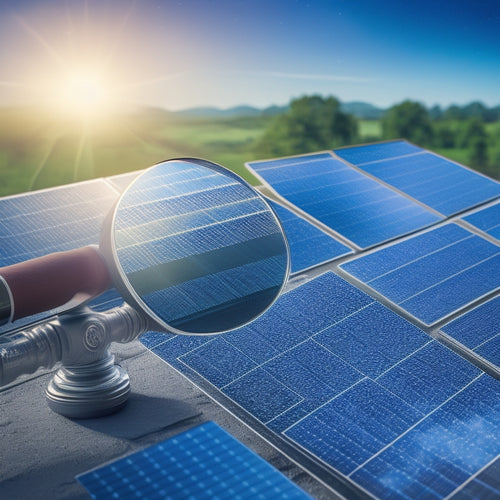
Maximize Solar Panel Efficiency: Essential Maintenance Tips
Share
To maximize your solar panel efficiency, you'll need to prioritize maintenance. Start by scheduling regular cleaning sessions every 6-12 months to remove debris and prevent energy losses. Inspect your system regularly for shading, debris, and electrical connection issues. Monitor your system's performance closely to detect potential problems before they escalate. Don't forget to trim trees and manage vegetation to prevent shading. By following these essential maintenance tips, you can boost your solar panel efficiency by up to 25%. Now, discover more ways to optimize your system's performance and maximize your return on investment.
Key Takeaways
• Regularly clean solar panels every 6-12 months to prevent debris buildup and maintain peak performance.
• Check electrical connections daily to prevent energy losses and tighten loose connections.
• Monitor system performance closely to identify potential issues and detect deviations from optimal energy output.
• Trim trees and manage vegetation to avoid shading and adjust trimming schedules for top energy production.
• Schedule annual professional inspections to identify early issues and maximize return on investment.
Schedule Regular Cleaning Sessions
Dust, dirt, and debris can reduce your solar panel's energy output by up to 25%, making regular cleaning sessions an essential aspect of maintaining peak performance. You might think, 'What's a little dirt, anyway?' But the truth is, dust accumulation can greatly impact your solar panel's energy production. And if you're not careful, you might be throwing money out the window – literally.
To minimize energy loss, it's important to clean your solar panels regularly. The frequency of cleaning depends on your panel angle and the environment it's exposed to. For example, if you live in a dusty area or near a construction site, you might need to clean your panels more frequently.
On the other hand, if you're in a relatively clean environment, you might get away with cleaning them every 6-12 months. Remember, a clean solar panel is a happy solar panel – and a happy wallet!
Inspect for Shading and Debris
To guarantee top energy production, you should regularly inspect your solar panels for shading and debris, as even partial blockages can greatly reduce their efficiency. Shading patterns can vary depending on the time of day, season, and surrounding environment, so it's crucial to monitor your panels regularly.
Take note of any obstructions, such as tree branches, buildings, or other structures that could be casting shadows on your panels. Even a small amount of shading can have a notable impact on energy production.
Debris accumulation is another common issue that can hinder solar panel performance. Dirt, leaves, and other debris can accumulate on your panels, reducing their ability to harness sunlight. Regularly inspect your panels for signs of debris buildup, and clean them accordingly.
Pay attention to areas around vents, gutters, and other crevices where debris tends to accumulate. By staying on top of shading and debris issues, you can ensure your solar panels operate at maximum efficiency, generating the most energy possible for your home or business.
Check Electrical Connections Daily
As you maintain your solar panel system, it's essential to check electrical connections daily to guarantee peak performance.
You'll want to scrutinize every connection, from the panels to the inverters, to identify any signs of wear or corrosion.
Tighten Loose Connections
Daily inspections of electrical connections are essential to prevent energy losses, as even slightly loose connections can greatly impede your solar panel's performance.
You'll be surprised how quickly energy losses can add up, making your solar panel system less efficient. To avoid this, you need to tighten any loose connections. Connection testing is key to identifying these issues. Start by checking the wire insulation for signs of wear or damage. If you notice any cracks or frays, it's time to replace the wire.
Next, inspect the connections themselves. Make sure they're secure and not loose. A simple tug on the wire will do the trick. If it comes loose, tighten it up! You can also use a multimeter to check for voltage drops across the connections. If you find any, it's likely due to a loose connection.
Clean Corroded Terminals
You'll need to regularly inspect and clean corroded terminals to prevent electrical connections from degrading and reducing your solar panel's efficiency. Corrosion causes electrical resistance, which increases with time, leading to reduced power output and even system failure. To avoid this, make it a habit to check your terminals daily.
Here are some tips to help you clean corroded terminals:
-
Use a soft-bristled brush or a cotton swab to gently remove corrosion and debris from the terminals.
-
Apply a small amount of terminal protector or silicone-based lubricant to protect the terminals from further corrosion.
-
Inspect the terminal materials, such as copper or aluminum, for signs of corrosion and replace them if necessary.
- Keep the terminal connections clean and dry to prevent moisture from accumulating and causing corrosion.
Monitor System Performance Closely
Regularly tracking your solar panel system's performance allows you to identify potential issues before they have a significant impact on energy production. By keeping a close eye on your system's performance, you'll be able to detect even slight deviations from the best energy output.
This proactive approach guarantees that minor issues don't escalate into major problems, saving you time, money, and stress in the long run.
To monitor your system's performance effectively, leverage data analytics and energy tracking tools. These advanced technologies provide real-time insights into your system's energy production, helping you identify areas of improvement and optimize energy output.
By analyzing your system's performance data, you'll be able to pinpoint inefficiencies, diagnose issues, and make data-driven decisions to maximize your solar panel system's efficiency.
Stay on top of your system's performance, and you'll be harvesting the full benefits of solar energy in no time!
Trim Trees and Manage Vegetation
By making sure that trees and vegetation surrounding your solar panel system are properly trimmed and managed, you can prevent energy losses due to shading and maintain peak energy production. It's crucial to keep those pesky branches and leaves from blocking sunlight and reducing your system's efficiency.
Here are some tips to help you trim and manage vegetation around your solar panels:
-
Schedule regular tree pruning: Hire a professional to prune trees that cast shade on your solar panels, especially during peak sun hours. This will guarantee maximum energy production and minimize energy losses.
-
Keep vegetation growth in check: Regularly trim back overgrown vegetation, such as bushes or vines, that may be blocking sunlight from reaching your solar panels.
-
Plant trees strategically: When planting new trees, consider the mature size of the tree and plant them far enough away to avoid future shading issues.
- Monitor vegetation growth seasonally: Keep an eye on vegetation growth during different seasons and adjust your trimming schedule accordingly to ensure top energy production.
Perform Inverter Maintenance Tasks
As you focus on maximizing your solar panel's efficiency, it's crucial to perform regular inverter maintenance tasks.
You'll want to regularly check your inverter's performance to make sure it's operating within the manufacturer's specifications, and update its firmware to take advantage of the latest features and improvements.
Inverter Performance Checks
You should conduct inverter performance checks every 6-12 months to guarantee maximum energy harvesting and identify potential issues before they escalate into significant problems. This proactive approach ensures your solar panel system operates at its best, and you reap the most benefits. Inverter diagnostics are essential in performance optimization, and regular checks help you stay on top of your system's game.
Here are some essential tasks to include in your inverter performance checks:
-
Monitor inverter efficiency: Keep an eye on the inverter's efficiency ratio to make sure it's within the manufacturer's specified range.
-
Check for error codes: Identify and troubleshoot any error codes that may indicate underlying issues.
-
Verify system configuration: Confirm that the inverter is configured correctly to match your solar panel array's specifications.
- Inspect for physical damage: Look for signs of physical damage, such as cracks, rust, or worn-out components, that could affect inverter performance.
Inverter Firmware Updates
Consistently updating your inverter's firmware guarantees that it remains optimized for peak performance, and you can take advantage of new features and improvements.
It's like keeping your smartphone's operating system up to date – you don't want to be stuck with an outdated system that's vulnerable to cybersecurity risks.
Outdated firmware can leave your inverter open to hacking, which could compromise your entire solar panel system.
Conduct Annual Professional Inspections
Regular professional inspections help identify potential issues before they escalate into costly problems, ensuring peak solar panel performance and maximizing your return on investment. By conducting annual inspections, you'll catch minor issues before they become major headaches. This proactive approach saves you time, money, and stress in the long run.
When scheduling an inspection, make sure to:
-
Check the inspector's qualifications: Look for certifications from reputable organizations, such as the North American Board of Certified Energy Practitioners (NABCEP).
-
Verify their experience with solar panel systems similar to yours.
-
Ask about their inspection process and what it entails.
- Clarify their inspection frequency recommendations, as it may vary depending on your system's size, age, and environmental conditions.
Frequently Asked Questions
Can I Use a Pressure Washer to Clean My Solar Panels?
"Don't even think about it! Using a pressure washer on your solar panels can cause water damage and compromise panel durability. Instead, gently hose them down with a soft-bristled brush to keep them sparkling and efficient."
How Often Should I Inspect My Solar Panel System?
You should inspect your solar panel system quarterly, ideally during seasonal changes, to catch potential issues before they escalate into costly Panel Wear; be proactive, not reactive!
Can I Perform Maintenance Tasks on My Solar Panel System Alone?
"You can try DIY maintenance, but be aware that personal liability and warranty coverage may be at risk; it's often safer to leave complex tasks to certified professionals to avoid voiding your warranty."
What Is the Ideal Angle for Solar Panels to Maximize Efficiency?
When optimizing your solar panel setup, you'll want to adjust the tilt to account for seasonal variations - a steeper angle in winter and shallower in summer - to maximize energy harvest, but be prepared for some Tilt Variations depending on your location.
Are There Any Solar Panel Maintenance Tasks I Can Automate?
You can automate tedious solar panel maintenance tasks with smart sensors and automated monitoring, freeing you up to focus on more exciting things - like calculating your energy savings!
Related Posts
-

Solar Panel System Certification Costs: A 10-Point Breakdown
You're looking to understand the costs associated with solar panel system certification. Your total certification cos...
-

Why Invest in Residential Solar Panel Systems?
By investing in a residential solar panel system, you'll harness renewable energy, reducing your carbon footprint and...
-

7 Ways to Save on Residential Home Solar Panels
You can save thousands on your residential home solar panels by leveraging financial incentives, dealer offers, and s...


